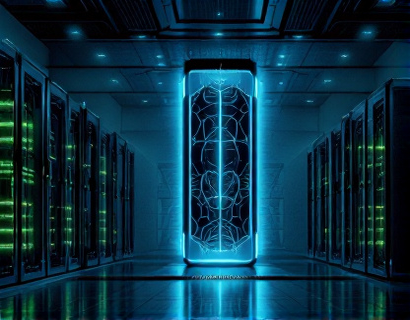Blockchain-Enabled Registry Software: Revolutionizing Data Management
In the rapidly evolving landscape of data management, the integration of blockchain technology has emerged as a transformative force, offering unparalleled security, transparency, and efficiency. This article delves into the profound impact of blockchain-enabled registry software, designed to revolutionize how professionals and enthusiasts approach data management, security, and digital transformation. By leveraging the inherent properties of blockchain, such as decentralization, immutability, and transparency, this software not only streamlines registry processes but also builds trust and accountability across various sectors.
Understanding Blockchain Technology
Before exploring the applications of blockchain-enabled registry software, it is essential to grasp the fundamental concepts of blockchain technology. At its core, a blockchain is a distributed ledger that records transactions across multiple computers in such a way that the registered transactions cannot be altered retroactively. This technology relies on a network of nodes, each maintaining a copy of the ledger, ensuring that no single entity has control over the entire system. The use of cryptographic hashing and consensus mechanisms further secures the blockchain, making it resistant to tampering and fraud.
Enhanced Security through Blockchain
One of the most significant advantages of blockchain-enabled registry software is its enhanced security features. Traditional registry systems are often centralized, making them vulnerable to cyber attacks, data breaches, and unauthorized access. In contrast, blockchain's decentralized nature distributes data across a network of nodes, reducing the risk of a single point of failure. Each transaction, or block, is encrypted and linked to the previous block, forming a chain that is nearly impossible to alter without consensus from the majority of the network. This immutability ensures that once data is recorded, it remains intact and verifiable, providing a robust defense against data manipulation and fraud.
Transparency and Trust
Transparency is another cornerstone of blockchain technology, and it plays a crucial role in building trust among users. In a blockchain-based registry, all transactions are recorded on a public ledger, accessible to all participants. This openness allows stakeholders to verify the authenticity and integrity of the data, fostering a higher level of trust. Unlike traditional systems where data is often siloed and controlled by a single entity, blockchain enables a collaborative environment where multiple parties can interact and validate information in real-time. This transparency is particularly valuable in industries such as finance, supply chain, and government, where trust and accountability are paramount.
Efficiency and Streamlined Processes
Blockchain-enabled registry software not only enhances security and transparency but also significantly improves efficiency. By automating and simplifying registry processes, organizations can reduce manual errors, decrease administrative overhead, and accelerate transaction times. Smart contracts, self-executing contracts with the terms directly written into code, further streamline operations by automatically enforcing and executing agreements when predefined conditions are met. This automation reduces the need for intermediaries, lowers costs, and increases the speed of transactions, making the entire process more efficient and user-friendly.
Applications Across Industries
The versatility of blockchain-enabled registry software makes it applicable across a wide range of industries. In the financial sector, it can enhance the security and efficiency of transactions, reduce fraud, and improve compliance with regulatory requirements. For supply chain management, blockchain provides end-to-end visibility, ensuring the authenticity and traceability of products from origin to destination. In the realm of healthcare, it can secure patient data, streamline record-keeping, and facilitate seamless information sharing among healthcare providers. Government and regulatory bodies can leverage blockchain to create transparent and tamper-proof records, enhancing public trust and governance.
Financial Sector
In finance, blockchain-enabled registry software can transform the way transactions are processed and recorded. Traditional banking systems often involve multiple intermediaries, leading to delays, high costs, and increased risk of errors. Blockchain's decentralized and transparent nature allows for direct peer-to-peer transactions, reducing the need for intermediaries and lowering transaction costs. Smart contracts can automate complex financial agreements, ensuring that all parties adhere to the terms without the need for manual intervention. This not only speeds up the process but also minimizes the risk of fraud and errors.
Supply Chain Management
Supply chain management is another area where blockchain-enabled registry software can bring significant benefits. By providing a transparent and immutable record of every step in the supply chain, from production to delivery, blockchain helps ensure the authenticity and quality of products. This is particularly crucial in industries dealing with high-value or sensitive goods, such as pharmaceuticals, luxury items, and food products. Blockchain can track the origin, movement, and condition of products, reducing the risk of counterfeiting and ensuring compliance with regulatory standards. This level of transparency also builds trust among consumers and partners, enhancing brand reputation and customer loyalty.
Healthcare
In the healthcare sector, blockchain-enabled registry software can revolutionize the way patient data is managed and shared. Patient records are often fragmented and stored in multiple systems, leading to inefficiencies and potential security risks. Blockchain provides a secure and centralized yet decentralized platform for storing and accessing patient data, ensuring privacy and integrity. Healthcare providers can access critical information quickly and securely, improving patient care and outcomes. Additionally, blockchain can facilitate the sharing of medical research data, accelerating the development of new treatments and therapies.
Government and Regulatory Bodies
For government and regulatory bodies, blockchain-enabled registry software offers a powerful tool for enhancing transparency and accountability. Public records, such as land registries, voting systems, and identity verification, can be secured and made more accessible through blockchain. This not only reduces the risk of corruption and fraud but also increases public trust in government institutions. Regulatory compliance becomes more straightforward as all transactions are recorded and verifiable, simplifying audits and inspections. Blockchain can also streamline bureaucratic processes, reducing administrative burdens and improving service delivery.
Implementation and Adoption
Implementing blockchain-enabled registry software requires a strategic approach to ensure successful adoption and integration. Organizations must first assess their specific needs and identify the areas where blockchain can add the most value. Collaboration with blockchain experts and technology partners is crucial to design a solution that aligns with the organization's goals and existing infrastructure. Pilot projects can help test the system, identify potential challenges, and refine the implementation plan. Education and training for staff are also essential to ensure a smooth transition and maximize the benefits of the new technology.
Challenges and Considerations
While the benefits of blockchain-enabled registry software are clear, there are several challenges and considerations to keep in mind. Scalability remains a significant issue, as blockchain networks can struggle to handle a high volume of transactions efficiently. However, ongoing developments in blockchain technology, such as layer 2 solutions and sharding, are addressing these concerns. Interoperability between different blockchain systems is another challenge, but standards and protocols are being developed to facilitate seamless communication. Regulatory frameworks are also evolving, and organizations must stay informed about compliance requirements in their respective industries.
Future Trends and Innovations
The future of blockchain-enabled registry software is promising, with ongoing innovations set to enhance its capabilities and broaden its applications. The integration of artificial intelligence and machine learning can further optimize data management, predictive analytics, and decision-making processes. Cross-chain interoperability will enable more seamless interactions between different blockchain networks, expanding the potential for collaborative solutions. Additionally, the development of more user-friendly interfaces and tools will make blockchain technology more accessible to a wider audience, fostering greater adoption across various sectors.
Conclusion
Blockchain-enabled registry software represents a significant leap forward in data management, offering enhanced security, transparency, and efficiency. By leveraging the unique properties of blockchain, organizations can transform their registry processes, build trust, and drive digital transformation. Whether in finance, supply chain, healthcare, or government, the benefits of this technology are vast and far-reaching. As the technology continues to evolve, the potential for innovation and improvement is immense, paving the way for a more secure, transparent, and efficient future.










































